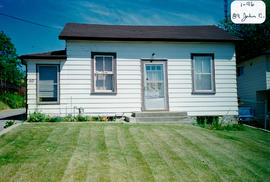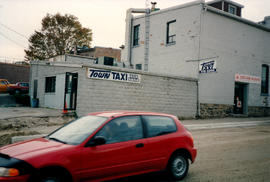- CA BWGPL GJ-HB-2017-03-27-03
- Item
- 1996
Part of George Jackson fonds
The mid-block structure located at 83 Holland St. East was built in the Ontario Vernacular Cottage style. It was constructed pre-1900 on what was once the site of a pop manufacturing plant. According to local history, bottles were still being unearthed many years later. After the plant closed, the property became the site of a blacksmith shop run by Bill Cukens. The house seen in this photo originally had a back kitchen and wood shed at the rear, as well as a large, two-storey barn with loft above (for horse feed). It was the home of Bob McKinstry, his wife and children Michael (Mike), Maisil, and Dorothy. Bob was a huge man and a blacksmith for several lumber companies after the local mills folded. He was also a noted field lacrosse player on the team that won the championship in 1905 (1907?). Bob and his son both played lacrosse until their worn-out legs forced them to quit. In those days, lacrosse players worked ten-hour days at hard physical labour, played lacrosse for a couple of hours, and then ran the six miles to Bond Head to cool off. Mike was a bookkeeper who also worked for his father in the garage and blacksmith shop. Maisil became a nurse and Dorothy worked in a restaurant and stayed at home to look after her family.
The one-storey, three-bay ‘cottage’ has a rectangular plan with a centre hall, a symmetrical façade, and a shallow-pitched, gable roof. The enclosed porch has a hip roof and the entrance is raised above grade level. There is a simple entrance with a single door with windows on each side. The porch stairs are not original and the entire porch may be a later addition. There are double-hung windows at the ground floor. The 2/2 widows appear to be original and are set into simple, rectangular openings with plain, wood surrounds and sills. Exterior aluminum storm windows are a later addition. The building has wood frame construction with vinyl siding and a stone-rubble foundation. It had wood cove siding originally. According to the 2000 inventory, the building’s form is one of the few existing original building elements. It also notes that the modest cottage probably had few decorative details originally. (1, 2, 3)
George Jackson






